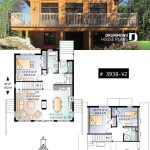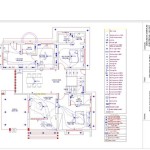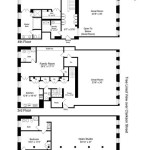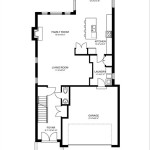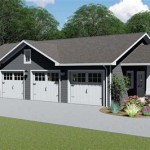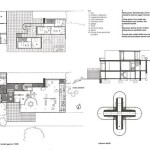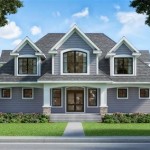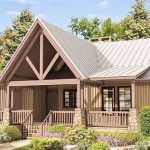Waterfront Home Plans for Narrow Lots: Maximizing Space and Views
The allure of waterfront living is undeniable. The serenity of the water, the breathtaking views, and the recreational opportunities all contribute to a desirable lifestyle. However, waterfront properties often come with spatial limitations, particularly narrow lot dimensions. Designing a waterfront home on a narrow lot presents unique challenges, demanding creative architectural solutions to maximize usable space, capture stunning views, and ensure structural integrity in potentially challenging environments.
This article explores the considerations and design principles involved in crafting waterfront home plans specifically tailored for narrow lots. It will delve into strategies for optimizing space utilization, maximizing views, and addressing the specific requirements of waterfront construction.
Understanding the Challenges of Narrow Waterfront Lots
Designing a home for a narrow waterfront lot necessitates acknowledging and overcoming several inherent challenges. Building codes and setbacks are often stricter in waterfront areas to protect the environment and ensure responsible development. These regulations can further constrict the buildable area on an already limited lot.
Furthermore, accessing the site for construction can be difficult due to the narrowness of the lot and its proximity to the water. This can increase construction costs and necessitate specialized equipment. Soil conditions in waterfront areas often require special foundation designs to prevent erosion and ensure the stability of the structure.
Privacy can also be a concern on narrow lots, as neighboring properties may be in close proximity. Careful planning is essential to create outdoor spaces that offer privacy without compromising views. Finally, the orientation of the lot relative to the sun and prevailing winds must be considered to optimize natural light, ventilation, and energy efficiency.
Key Design Principles for Narrow Waterfront Home Plans
Successfully designing a waterfront home for a narrow lot requires the application of specific design principles that prioritize efficiency, functionality, and aesthetic appeal. These principles include vertical building strategies, open floor plans, maximization of natural light and views, and careful consideration of outdoor living spaces.
Vertical Building Strategies: Building up, rather than out, is crucial for maximizing space on a narrow lot. Multi-story designs allow for more living area without encroaching on setbacks or compromising outdoor space. Strategic use of balconies, decks, and rooftop terraces can further extend living spaces and provide stunning views. Elevators or stair lifts may be necessary to ensure accessibility in multi-story homes.
Open Floor Plans: Open floor plans create a sense of spaciousness by eliminating unnecessary walls and partitions. This allows natural light to flow freely throughout the home and maximizes views from multiple rooms. The kitchen, dining, and living areas can be seamlessly integrated to create a cohesive and functional living space. Thoughtful furniture placement and the use of area rugs can help define distinct zones within the open plan.
Maximizing Natural Light and Views: Large windows, sliding glass doors, and skylights are essential for capturing natural light and maximizing views of the water. The orientation of the home should be carefully considered to take advantage of solar gain during the winter months and minimize heat gain during the summer. Window treatments can be used to control glare and provide privacy. Strategic placement of mirrors can also enhance natural light and create the illusion of more space.
Outdoor Living Spaces: Outdoor living spaces are an integral part of waterfront living. Decks, patios, and balconies can extend the living area and provide opportunities for relaxation and entertainment. Careful planning is essential to ensure privacy and protection from the elements. Consider adding features such as outdoor kitchens, fireplaces, and seating areas to create inviting and functional outdoor spaces. Landscaping can also be used to enhance privacy and create a transition between the home and the waterfront.
Structural and Material Considerations for Waterfront Construction
Waterfront construction presents unique structural and material challenges that must be addressed to ensure the longevity and safety of the home. The corrosive effects of salt water, the potential for flooding, and the dynamic forces of wind and waves all require careful consideration during the design and construction process.
Foundation Design: The foundation is the most critical element of a waterfront home. Depending on the soil conditions and the risk of flooding, various foundation options may be considered. These include piling foundations, concrete slab foundations, and raised foundations. Piling foundations are often used in areas with unstable soil or a high water table. Concrete slab foundations are a cost-effective option for stable soil conditions. Raised foundations elevate the home above the flood plain, providing protection from flooding and storm surge. A qualified structural engineer should be consulted to determine the most appropriate foundation design for the specific site conditions.
Building Materials: The choice of building materials is also crucial for waterfront construction. Materials should be durable, weather-resistant, and resistant to corrosion and decay. Pressure-treated lumber, composite decking, and stainless steel fasteners are commonly used in waterfront construction. Fiber cement siding, stucco, and brick are durable exterior cladding options that can withstand the harsh coastal environment. Metal roofing is another popular choice for waterfront homes due to its durability and resistance to high winds.
Waterproofing and Drainage: Proper waterproofing and drainage are essential to prevent water damage and mold growth. The building envelope should be carefully sealed to prevent water intrusion. Gutters and downspouts should be properly sized and installed to effectively channel rainwater away from the foundation. AFrench drain can be installed to intercept groundwater and divert it away from the home.
Innovative Design Solutions for Maximizing Space
Beyond the core design principles, several innovative design solutions can further enhance the functionality and aesthetic appeal of a narrow waterfront home. These solutions include the integration of smart home technology, the use of flexible spaces, and the incorporation of sustainable design principles.
Smart Home Technology: Smart home technology can enhance the convenience and efficiency of a waterfront home. Automated lighting and climate control systems can optimize energy consumption and create a comfortable living environment. Security systems can provide peace of mind and protect the property from intruders. Smart appliances can simplify daily tasks and enhance the functionality of the kitchen.
Flexible Spaces: Designing flexible spaces that can serve multiple purposes is a smart way to maximize space in a narrow home. A guest room can double as a home office, a dining room can be converted into a playroom, and an outdoor deck can be used for both dining and relaxation. Furniture that can be easily reconfigured or stored away can also help to maximize space.
Sustainable Design Principles: Incorporating sustainable design principles can reduce the environmental impact of the home and lower operating costs. Solar panels can generate electricity and reduce reliance on fossil fuels. Rainwater harvesting systems can collect rainwater for irrigation and other non-potable uses. Energy-efficient appliances, windows, and insulation can reduce energy consumption. Landscaping with native plants can reduce the need for irrigation and fertilization.
In conclusion, designing a waterfront home for a narrow lot presents unique challenges and opportunities. By carefully considering the constraints of the site and applying innovative design solutions, it is possible to create a beautiful, functional, and sustainable home that maximizes space, captures stunning views, and enhances the waterfront lifestyle.

The Right Fit House Plans For Narrow Lots Houseplans Blog Com

Narrow Beach Waterfront Lot House Plans Weber Design Group Naples Fl

Narrow Lot Beach House Home Bunch Interior Design Ideas

House Plan Of The Week Narrow Lot Beach Home Designers

Aaron S Beach House Coastal Plans From Home

Beach House Plan Cottage Home Floor For Narrow Coastal Lot Plans Florida

House Plan Of The Week Narrow Lot Beach Home Designers

House Plan 963 00454 Narrow Lot 3 209 Square Feet Bedrooms 5 Bathrooms Plans Beach Flooring Modern

Plan 041h 0135 The House

Narrow Lot Beach House Home Bunch Interior Design Ideas

